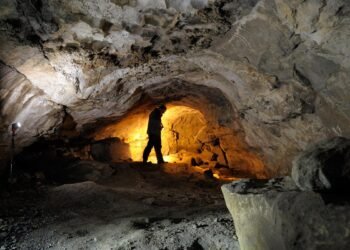A recent study led by Dr. Mikael Fauvelle, published in the Journal of Maritime Archaeology, proposes that the ancient Scandinavian Pitted Ware Culture (PWC) may have constructed boats using animal skins, specifically seal hides, to navigate, fish, hunt, and trade across vast distances. The PWC thrived between 3500 and 2300 BCE in regions surrounding the Baltic and North Seas, including parts of modern-day Sweden, Denmark, and Finland.

The PWC, known primarily for their distinctive pottery decorated with deep pits, were a maritime culture that heavily relied on the sea for survival. Unlike other Neolithic groups in Europe that gradually adopted agriculture, the PWC maintained a hunter-gatherer lifestyle, specializing in seal hunting and fishing. According to Dr. Fauvelle, seal hunting was a critical part of their subsistence strategy, as evidenced by the large amounts of seal bones discovered at PWC archaeological sites.
Dr. Fauvelle explained in an interview with Live Science that seal hides and seal oil were likely used in boat construction. “Seals were one of the best animals for making boats,” he said, drawing parallels with Inuit cultures that applied seal oil to waterproof their skin boats. Traces of seal oil have been found inside pottery at PWC sites, further supporting this theory. The researchers suggest that the PWC used seal hides stretched over wooden frames to build skin boats capable of navigating open seas.
The PWC’s reliance on maritime travel is evident from their movement across large bodies of water, including the Baltic Sea and the Kattegat and Skagerrak straits. Archaeologists have found lithic tools, animal remains, and clay sourced from various regions in Scandinavia, indicating long-distance trade and voyages.

Logboats, or dugout canoes, have also been found at some PWC sites, but these boats were typically small and unsuitable for open-sea travel. Dr. Fauvelle and his colleagues argue that skin boats would have been more effective for long-distance voyages. “Compared to logboats, we argue that skin boats would have been better for long-distance and open-ocean transport,” said Fauvelle.
The physical evidence for skin boats is scarce, as such vessels decay rapidly and do not preserve well in archaeological records. However, researchers have uncovered indirect evidence, such as bone frames recovered in Sweden and northern Germany, which may have been used to sew skins into boat structures.
Additionally, rock art from northern Scandinavia depicts scenes of seal hunting and fishing, key activities of the PWC. These images also show boats with harpoon rests that resemble animal heads, a feature seen in traditional Inuit Umiak skin boats. The transparency of the depicted boats in some rock art, where the outlines of people inside the boats are visible, further suggests that these vessels were made from skin, as light passing through the material could create this visual effect.
Aside from rock art and fragments of possible boat frames, other indirect evidence points to the use of skin boats. The abundance of scrapers and awls at PWC sites, tools used for processing hides, indicates that large quantities of seal hides were likely prepared for purposes beyond clothing.
The presence of seal oil, which was essential for waterproofing skin boats, further supports this hypothesis. Seal oil would have had to be reapplied regularly to keep the boats seaworthy, which might explain the large quantities of seal remains and oil found at PWC sites.
While definitive evidence of skin boat construction by the PWC remains elusive, the combination of indirect clues paints a compelling picture. These boats would have enabled the PWC to continue their specialized hunting and fishing practices, while also facilitating long-distance trade and travel.
Dr. Fauvelle noted that while skin boats likely played a significant role during the Neolithic period, their use may have diminished by the Bronze Age, when plank-sewn boats became more common.
“The introduction of plank boat technology brought many other technological and social changes during the Bronze Age,” he said, though it is still unclear how exactly these new innovations were adopted by Scandinavian societies.





















